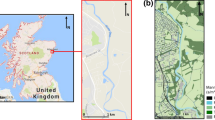Abstract
This paper uses a sensitivity framework approach to look at the probabilistic impacts of climate change on 20-year return period flood peaks, by applying a set of typical response surfaces alongside the probabilistic UK Climate Projections (UKCP09) for 10 river-basin regions over Scotland. The first paper of the pair used the same approach for 10 river-basin regions over England and Wales. This paper develops the methodology for Scotland, by first enabling better estimation of the response type of Scottish catchments. Then, as for England and Wales, the potential range of impacts is shown for different types of catchment in each river-basin region in Scotland, and regional average impact ranges are estimated. Results show clear differences in impacts between catchments of different types and between regions. The Argyll and West Highland regions show the highest impacts, while the North-East Scotland region shows the lowest impacts. The overall ranges are generally smaller for Scotland than England and Wales.







Similar content being viewed by others
References
Bayliss A (1999) Catchment descriptors. In: The flood estimation handbook, vol 5. Institute of Hydrology, Wallingford, UK
Boorman DB, Hollis JM, Lilly A (1995) Hydrology of soil types: a hydrologically based classification of soils in the United Kingdom. IH report no. 126, Institute of Hydrology, Wallingford
Crooks SM, Kay AL, Reynard NS (2009) Regionalised impacts of climate change on flood flows: hydrological models, catchments and calibration. Report to Department for Environment, Food and Rural Affairs, FD2020 project milestone, CEH Wallingford, Nov 2009
IPCC (2000) Special report on emissions scenarios (SRES): a special report of Working Group III of the Intergovernmental Panel on climate change. Nakicenovic N, Swart R (eds). Cambridge University Press, Cambridge
Kay AL, Crooks SM (2013) An investigation of the effect of transient climate change on snowmelt, flood frequency and timing in northern Britain. Int J Climatol. doi:10.1002/joc.3913 (in press)
Kay AL, Crooks S, Davies HN, Prudhomme C, Reynard NS (2011a) Practicalities for implementing regionalised allowances for climate change on flood flows. Report to Department for Environment, Food and Rural Affairs, Technical Report FD2648, CEH Wallingford, May 2011
Kay AL, Crooks SM, Davies HN, Reynard NS (2011b) An assessment of the vulnerability of Scotland’s river catchments and coasts to the impacts of climate change: work package 1 report. Report to Scottish Environment Protection Agency, CEH Wallingford, Aug 2011
Kay AL, Crooks SM, Davies HN, Prudhomme C, Reynard NS (2013a) Probabilistic impacts of climate change on flood frequency using response surfaces I: England and Wales. Reg Environ Change. doi:10.1007/s10113-013-0563-y
Kay AL, Crooks SM, Reynard NS (2013b) Using response surfaces to estimate impacts of climate change on flood frequency: assessment of uncertainty. Hydrol Process. doi:10.1002/hyp.10000
Kjellstrom E, Boberg F, Castro M, Christensen H, Nikulin G, Sanchez E (2010) Daily and monthly temperature and precipitation statistics as performance indicators for regional climate models. Clim Res 44:135–150
Köplin N, Schädler B, Viviroli D, Weingartner R (2012) Relating climate change signals and physiographic catchment properties to clustered hydrological response types. Hydrol Earth Syst Sci 16:2267–2283
Marsh TJ, Hannaford J (eds) (2008) UK hydrometric register. Hydrological data UK series, Centre for Ecology and Hydrology
Murphy JM, Sexton DMH, Jenkins GJ, Booth BBB, Brown CC, Clark RT, Collins M, Harris GR, Kendon EJ, Betts RA, Brown SJ, Humphrey KA, McCarthy MP, McDonald RE, Stephens A, Wallace C, Warren R, Wilby R, Wood RA (2009) UK climate projections science report: climate change projections. Met Office Hadley Centre, Exeter
Prudhomme C, Wilby RL, Crooks S, Kay AL, Reynard NS (2010) Scenario-neutral approach to climate change impact studies: application to flood risk. J Hydrol 390:198–209
Prudhomme C, Crooks S, Kay AL, Reynard NS (2013a) Climate change and river flooding: Part 1 classifying the sensitivity of British catchments. Clim Change 119(3–4):933–948. doi:10.1007/s10584-013-0748-x
Prudhomme C, Kay AL, Crooks S, Reynard NS (2013b) Climate change and river flooding: Part 2 sensitivity characterisation for British catchments and example vulnerability assessments. Clim Change 119(3–4):949–964. doi:10.1007/s10584-013-0726-3
Thompson N, Barrie IA, Ayles M (1982) The meteorological office rainfall and evaporation calculation system: MORECS (July 1981). Hydrological memorandum no. 45, Met Office, Bracknell
Wang Y, Lovell L, Wicks J (2013) Thinking big: national scale flood mapping. In: International conference on flood resilience: experiences in Asia and Europe, Exeter, UK, 5–7 Sep 2013
Weiß M, Alcamo J (2011) A systematic approach to assessing the sensitivity and vulnerability of water availability to climate change in Europe. Water Resour Res 47:W02549
Wetterhall F, Graham LP, Andréasson J, Rosberg J, Yang W (2011) Using ensemble climate projections to assess probabilistic hydrological change in the Nordic region. Nat Hazards Earth Syst Sci 11:2295–2306
Acknowledgments
This research was supported by the Scottish Environment Protection Agency (SEPA) (contract R10023PUR) with additional contribution from the NERC-CEH Water science programme. The UK Climate Projections data have been made available by the Department for Environment, Food and Rural Affairs (Defra) and Department for Energy and Climate Change (DECC) under licence from the Met Office, Newcastle University, University of East Anglia and Proudman Oceanographic Laboratory. These organisations accept no responsibility for any inaccuracies or omissions in the data, nor for any loss or damage directly or indirectly caused to any person or body by reason of, or arising out of, any use of this data.
Author information
Authors and Affiliations
Corresponding author
Electronic supplementary material
Below is the link to the electronic supplementary material.
Rights and permissions
About this article
Cite this article
Kay, A.L., Crooks, S.M., Davies, H.N. et al. Probabilistic impacts of climate change on flood frequency using response surfaces II: Scotland. Reg Environ Change 14, 1243–1255 (2014). https://doi.org/10.1007/s10113-013-0564-x
Received:
Accepted:
Published:
Issue Date:
DOI: https://doi.org/10.1007/s10113-013-0564-x




